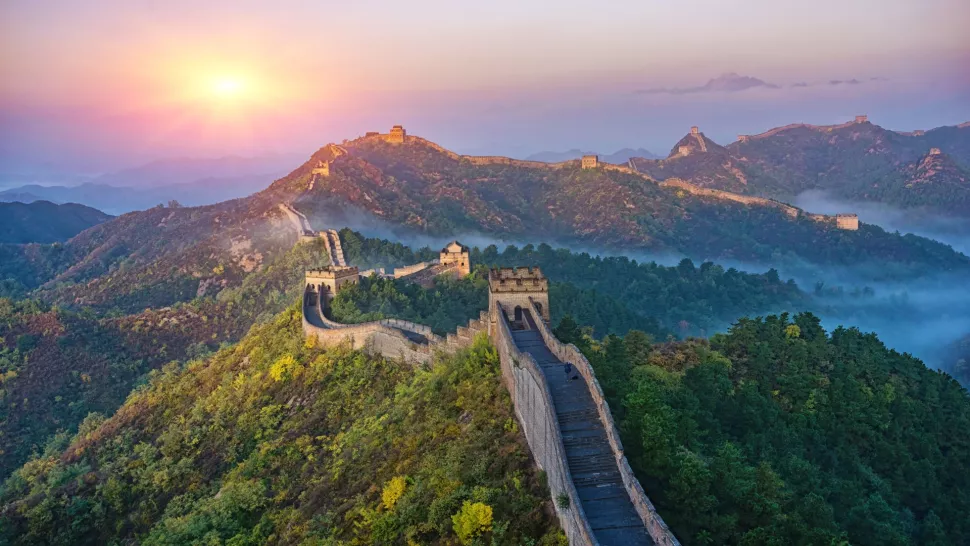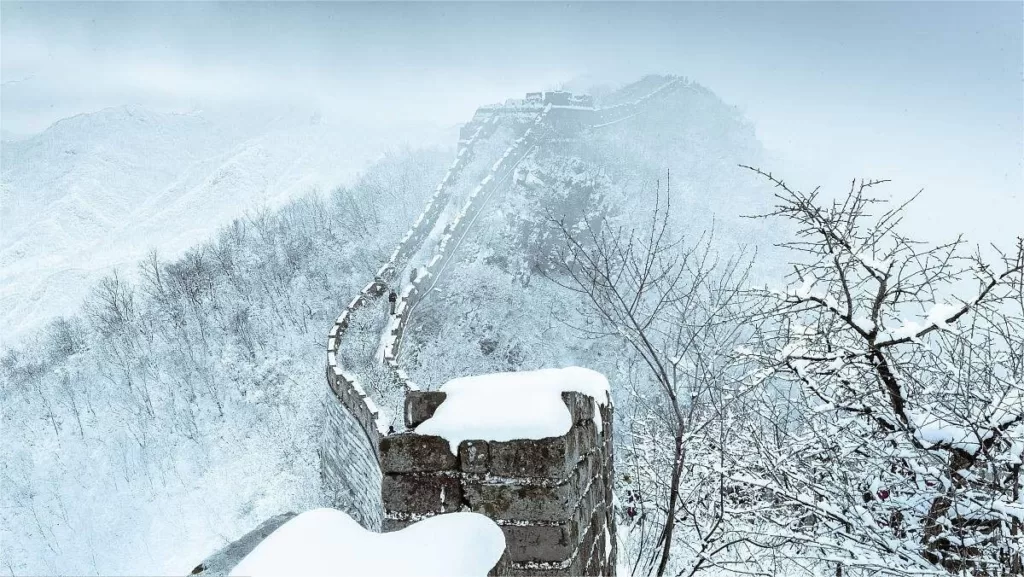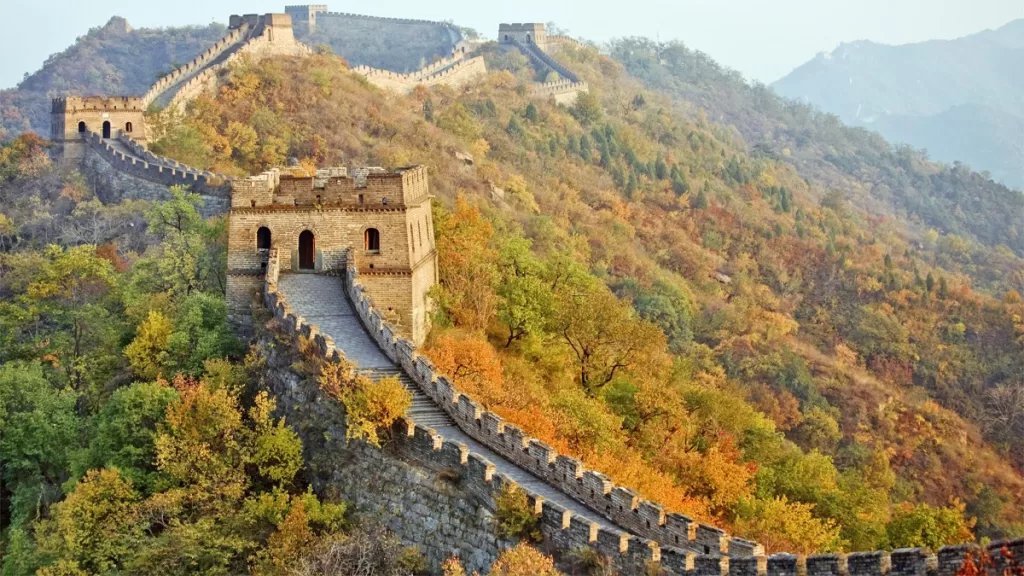Simatai Great Wall (司马台长城) is a section of the Great Wall of China located in Beijing, about 120 km northeast of the city center. It is known for its steep gradients, narrow paths, and picturesque views. Simatai Great Wall is one of the best-preserved sections of the Great Wall, and it is a UNESCO World Heritage site.
The wall at Simatai was first built during the Northern Qi Dynasty (550-577 AD) and was later renovated and expanded during the Ming Dynasty (1368-1644 AD). The section is characterized by its unique features such as the double-layered walls, densely packed watchtowers, and steep staircases.
Simatai Great Wall is divided into two parts: the eastern section and the western section. The eastern section is known for its steep gradients and 15 watchtowers, while the western section is famous for its 20 watchtowers and stunning scenery.
Visitors can enjoy a range of activities at Simatai Great Wall, such as hiking, camping, and sightseeing. The best time to visit is during the autumn when the foliage turns golden and the weather is mild. Simatai Great Wall is a must-visit destination for anyone interested in history, culture, and natural beauty.
Table of Contents
- Basic Information
- Location and Transportation
- Highlights of Simatai Great Wall
- Map and Best Time to Visit
- Vlog about Simatai Great Wall
- History of Simatai Great Wall
- Useful Tips Summarized from Reviews
- Other Sections of Great Walls in Beijing
Basic Information
| Website | http://www.wtown.com/ |
| Estimated Length of Tour | Over 3 hours |
| Ticket Price | The wall: 40 RMB Admission + Single-Way cable car: 110 RMB Admission + Round cable car: 180 RMB Night Tour (Admission to the wall + return cable car): 160 RMB |
| Opening Hours | Day tour: 9.00 – 17.00; Last admission: 15.00 Night tour: 18.30 – 20.40 (1st May – 31st October) 17.30 – 20.10 (1st November – 30th April the next year) |
| Telephone Number | 0086-010-81009999 |
Location and Transportation
Simatai Great Wall is located in the northeastern part of Beijing, in the Gubeikou Town of Miyun County. It is situated on the rugged mountains and ridges of the Yanshan range, which stretches across northern China.
You can take a coach at Dongzhimen Station (东直门) and then transfer to the shuttle bus at Gubei Water Town. The whole journey takes about 3 hours. Alternatively, you can use the private transfer service, which will pick you up at your hotel or home and take you directly to Simatai Great Wall.
Highlights of Simatai Great Wall
Steep Gradients and Narrow Paths

The steep gradients and narrow paths of the Simatai Great Wall are some of its most challenging and exciting features. The wall is built along a rugged mountain range, and the terrain is steep and uneven. The gradients are so steep that visitors often need to use their hands to climb up or down. The narrow paths are only wide enough for one person to pass through at a time, adding to the wall’s sense of adventure and exploration. These features also made it more difficult for invading armies to scale the wall, making it a crucial military fortification during ancient times.
Double-Layered Walls

Unlike most sections of the Great Wall, which have a single-layered wall, the Simatai section has two layers of walls. The inner wall is higher and thicker than the outer wall, providing extra protection against invaders. The walls were built using bricks and stones, and they have stood the test of time, with some sections dating back to the 6th century. The double-layered walls are a testament to the wall’s advanced construction and engineering techniques, and they offer visitors a rare glimpse into the ancient military defenses of China.
Watchtowers

The Simatai Great Wall is renowned for its dense and compact watchtowers, which played a crucial role in the defense of the wall. There are a total of 35 watchtowers in the eastern and western sections of the wall, with varying shapes and sizes. The watchtowers were strategically placed along the wall to provide maximum visibility and communication between the different sections. Visitors can climb up the watchtowers and enjoy panoramic views of the surrounding mountains and valleys. Some of the watchtowers have been restored to their original condition, while others have been modified for easier access.
Night Tours

Simatai Great Wall is one of the few sections of the Great Wall that offers night tours, providing visitors with a unique and unforgettable experience. During the night tour, the wall is illuminated with soft lights, creating a magical and romantic atmosphere. Visitors can explore the wall under the stars, taking in the peaceful and serene surroundings. The night tours also offer a break from the crowds and heat of the day, making it a perfect option for those who prefer a more relaxed and intimate experience.
Natural Beauty

Simatai Great Wall is not only renowned for its impressive military architecture and engineering, but also for its stunning natural beauty. The wall is built on rugged mountains and ridges, surrounded by picturesque landscapes and panoramic views. Visitors can take scenic walks and hikes, exploring the surrounding forests, valleys, and lakes. The nearby Miyun Reservoir and Gubei Water Town offer a tranquil and peaceful atmosphere, making it a perfect escape from the hustle and bustle of Beijing city.
Map and Best Time to Visit

The entire climb takes about 3-4 hours. The section between towers 2 and 3 and between towers 4 and 5 is quite steep, making the first half challenging, while the second half is more manageable. Overall, it is still relatively easy to climb. After getting off the shuttle bus, you can choose to take a cable car or walk up. There are two points between towers 5 and 6 and near tower 8 where you can access the cable car.
Toilets: Once inside the scenic area, toilets are only available at the upper and lower cable car stations. None of the ten towers have toilet facilities.
Best Time to Visit: The best time to visit the Simatai Great Wall is in autumn. During this season, the scenery is especially beautiful, with the Great Wall appearing even more magnificent and enchanting against the natural landscape. Additionally, the weather in autumn is ideal, neither too hot nor too cold, providing a comfortable environment for visitors.
Vlog about Simatai Great Wall
History of Simatai Great Wall
During the Hongzhi era of the Ming Dynasty, nine major military garrisons were gradually established along the northern border of the Great Wall, collectively known as the “Nine Border Towns.” These garrisons played a crucial role in defending against the remnants of Mongolian forces. Miyun, under the jurisdiction of the Jizhen garrison, was a key area that stretched from Shanhaiguan in the east to Huilingkou near Juyongguan in the west, covering over 1200 li (approximately 600 kilometers).
The Jizhen section of the Great Wall was of paramount importance due to the frequent incursions by nomadic tribes such as the Tatars, Oirats, and Jurchens, who often raided areas outside Beijing, sometimes penetrating as far as Changping and Tong County. These threats necessitated a strong defensive presence in the region.
The Miyun section of the Great Wall spans 425 li (approximately 212 kilometers). The Ming Dynasty established four military camps and key passes at Wall Road, Caojia Road, Gubeikou, and Shitang Road, centered around Shixia. Each route was responsible for guarding several segments of the Great Wall, with soldiers trained during peacetime and ready to fight during wartime. This created a systematic defensive network.
The Jizhen Great Wall was designed and constructed under the direction of famous Ming generals like Liu Yingjie, Tan Lun, and Qi Jiguang, who was also renowned for his role in defending against Japanese pirates. This section of the wall is characterized by its height, thickness, and the density of watchtowers and beacon towers, which served multiple purposes and showcased the architectural features of the Great Wall across China.
Tourism at Juyongguan and Badaling sections of the Great Wall began early, making them famous spots for viewing the Jizhen Great Wall. To alleviate the overcrowding at Badaling, other sections such as Mutianyu and Jinshanling were later opened to tourists.
Simatai Great Wall is part of the Jizhen Great Wall, specifically built to guard Gubeikou. Historically, Gubeikou has been a strategically important military site, defended by the interconnected Great Wall sections of Wohu Mountain, Panlong Mountain, Jinshanling, and Simatai. This area represents one of the most complete Great Wall systems in Chinese history.
Useful Tips Summarized from Reviews
Duration and Physical Preparation: Climbing the entire length of Simatai Great Wall typically takes around 4 hours, with half the time spent ascending and the other half descending. It’s essential to be well-prepared with sunscreen and carry an ample supply of water. If you’re not confident in your physical stamina, it’s advisable to consider taking the cable car for either the ascent, descent, or both.
Challenging Terrain: Some sections of the wall feature high and narrow steps, requiring careful footing. Additionally, certain segments lack the protective barrier of the wall, with cliffsides secured only by iron chains. This can be particularly daunting for those with a fear of heights.
Scenic Highlights: The most breathtaking scenery at Simatai Great Wall is concentrated between Watchtowers 4 and 10. Some of these watchtowers offer views through their doorways that seem to overlook sheer cliffs and precipices. From Watchtower 9 to 10, you’ll encounter the flattest section of the west segment, with two watchtowers perched precariously atop rocky outcrops, flanked by steep cliffs on either side, creating a truly awe-inspiring vista.
Day or Night Visit: Simatai Great Wall can be visited both during the day and at night. Night tours offer a unique perspective, especially during the summer when the scenery is illuminated. However, it’s important to note that during night tours, only a small section of the Great Wall, typically from Watchtowers 5 to 6, is open for exploration. Additionally, there are time restrictions on nighttime visits. If you’re unable to catch the sunset, the experience may not be as rewarding, making it more suitable for photography enthusiasts.






